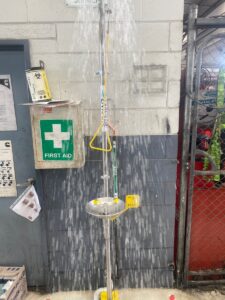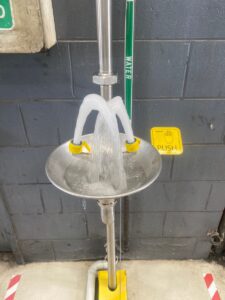Installing Eyewash Stations And Safety Showers In Melbourne – Crucial Workplace Compliance Plumbing
Australian Eyewash stations and Safety Showers Requirements
The Wyndham, Brimbank and Hobsons Bay municipalities are home a plethora of factories, tertiary education campuses and laboratories, many of which involve manufacturing (or training/learning) with harmful substances. Each of these workplaces must comply with WorkSafe regulations and Australian Standards surrounding their production methods.
Emergency safety showers and eyewash equipment must be provided where there is a risk of hazardous chemicals or infectious substances that can cause eye injuries.
While any tap can provide some assistance in an emergency eye injury situation, eyewash stations and showers are purpose built for immediate access, practical to use by an injured/wounded person and have the required water pressure necessary to prevent permanent damage to an injured person’s eye.
Compliance with OSH regulations and regular testing of these stations ensure that they will function properly in the event of an emergency and can prevent serious injury or even death. Employers have a responsibility to provide and maintain these stations, as well as to train employees on their proper use. Failure to comply with these regulations and neglecting regular testing of safety showers and eye wash stations can result in fines or other WorkSafe breaches through an audit. The regulations workplaces need to follow fall under the Australian Standards AS4775-2007 Emergency Eyewash and Shower Equipment.

How do Eyewash Station and Safety Showers Work
Eyewash stations have a basin not dissimilar to a standard bathroom basin, but that’s where the similarities end. Instead of a mixer or pillar tap, eyewash stations are operated by hand and foot pedals. These are bright yellow in colour and will provide instantaneous water flow by either stepping on the pedal or pushing a large hand plate.
There are two spouts, angled to point directly to both of the user’s eyes. They have a cover on them when not in use which flicks open when the tap is turned on. These spouts are also yellow/red in colour for visibility.
The safety shower (often connected as a multi system unit) has a large, rounded pull rod, either this or the shower head itself will also be yellow/red in colour for visibility.
Eye injuries can be extremely serious when gained from hazardous materials and chemicals such as acids in laboratories and factories and can result in permanent tissue damage, blindness and even death. Safety showers and eyewash stations must not only be installed correctly, but properly maintained to ensure they work immediately when needed.

How Often Do Eyewash Station and Safety Showers Need Testing to Remain Compliant?
For compliant shower and eye wash stations, annual testing is essential for maintaining a safe and healthy work environment for those workplaces with chemical exposure risks.
Compliance with OSH regulations, Australian Standards AS4775-2007 Emergency Eyewash and Shower Equipment and regular testing of these stations ensure that they will function properly in the event of an emergency, and can prevent serious injury or even death.
Employers have a responsibility to provide and maintain these stations, as well as to train employees on their proper use. Failure to comply with regulations and neglecting regular testing of safety showers and eye wash stations can result in fines or other penalties from WorkSafe.

Safety Shower and Eyewash Station Minimum Performance Checklist
McCarthy Plumbing Group plumbers follow an essential performance audit when installing safety showers and eyewash stations as per the AS4775/2007 standards, and employers must also follow these standards to ensure their safety equipment is functioning at all times. Minimum performance criteria for both installation and testing include:
- All installations following plumbing regulations and are installed by licensed and insured plumbers.
- Safety equipment must have a continuous water supply connection.
- Safety showers and eyewash stations must be accessible within 10 seconds (or 15 metres) of hazardous chemicals and the path to the safety equipment must be free of any obstructions
- Employee training is crucial to ensure appropriate operation.
- Safety equipment should be used weekly to ensure its in working condition and flushed
- The safety equipment must be tested annually for compliance with AS4775/2007
- Showerheads must be installed between 2083mm and 2438mm from the ground.
- Safety Showers must deliver a min of 75.7 L/min of drinking water at 210kPa
- Eyewash Stations must deliver a min of 1.5 L/min of drinking water at 210kPa
- Safety Equipment must be highly visible with signage
Our plumbers will conduct the above checks during an inspection, water pressure testing and the integrity of the tapware. Recently during an eyewash and safety shower annual inspection one of our plumbers found that the safety equipment had inappropriate water pressure and after an internal unit check it was found the aerator and rubber had perished and needed replacing.

Do you need an Eyewash Station or Safety Shower installation Melbourne?
We are often called by clients who have been breached or received audit reports from WorkSafe and require safety equipment rectifications. We have shower and eye wash test kits (which include bins, nylon test socks, eyewash test pattern gauges, and eyewash aerator removal key) and will tag each piece of safety equipment after the test has passed.
McCarthy Plumbing Group have years of expertise and a proven track record of delivering exceptional results for our commercial and industrial clients and are proficient in workplace and OHS compliance plumbing solutions, including the installation and compliance testing of Eyewash Stations and Safety Showers.

